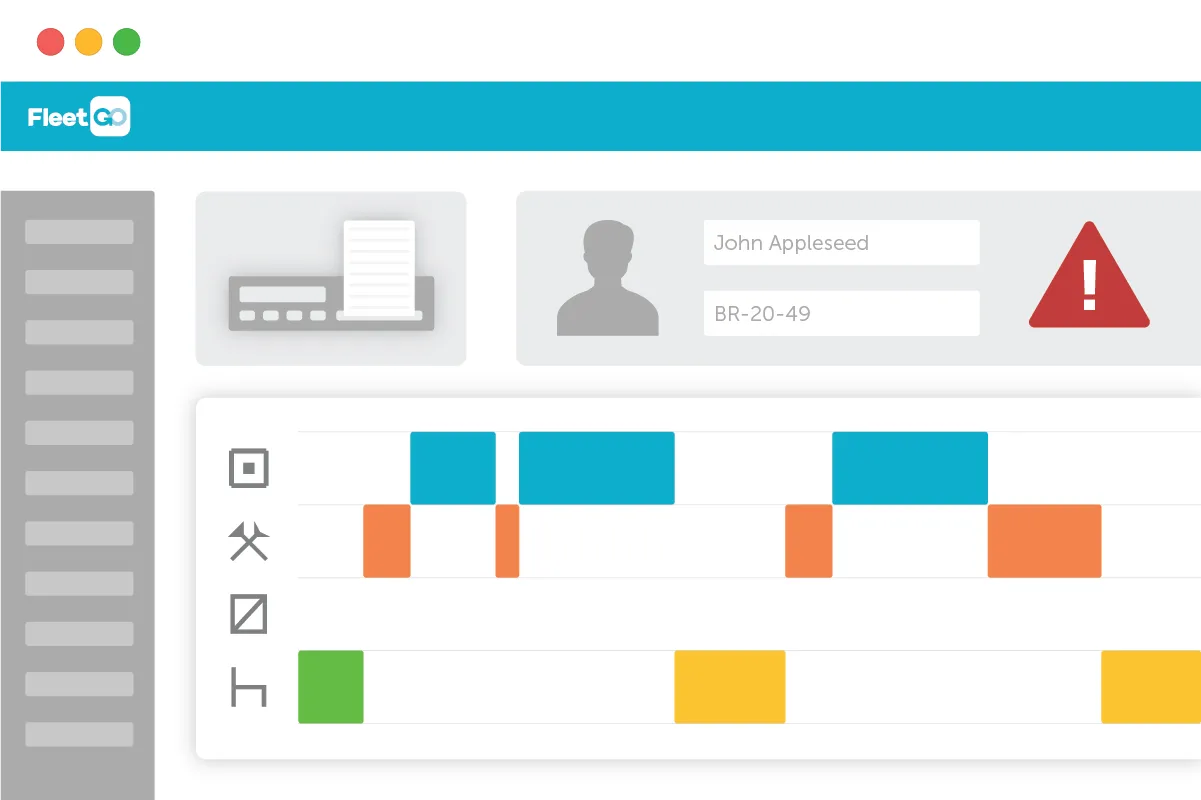Since the introduction in 2006 of the EU regulation to harmonise road traffic within the EU, the digital tachograph has become a compulsory feature for new vehicles and has therefore gradually replaced analogue tachographs.
But whether your business actually requires a tachograph or not depends largely on the type and purpose of transport. The largest permissible total weight as well as the place of origin and destination of the transported goods also play decisive roles. Given the great complexity of this subject, we have created an overview to help you obtain key information regarding exemptions from tachograph requirements.

Exemptions from EU law
Some types of vehicle are exempt from EU rules. This means they come under GB domestic rules in the UK. The main types of exempt vehicle are:
- vehicles that cannot go faster than 40 kilometres per hour, including vehicles that are restricted by a set speed limiter
- emergency aid vehicles – vehicles used in the non-commercial transport of humanitarian aid for use in emergencies or rescue operations
- breakdown vehicles – specialised breakdown vehicles working within a 100km of their base
- vehicles undergoing road tests for technical development, repair or maintenance purposes, and new or rebuilt vehicles which have not yet been put into service
- non-commercial vehicles under 7.5 tonnes – for example a person moving house or goods carried by a non-profit making group or registered charity
- vehicles manufactured more than 25 years ago
- vehicles used by agricultural, horticultural, forestry, farming or fishery businesses for carrying goods within 100km of where the business is based
- vehicles that are used to carry live animals between a farm and a market, or from a market to a slaughterhouse where the distance is less than 100km
- vehicles that are used to carry animal waste or carcasses that are not intended for human consumption
- educational vehicles, for example play buses and mobile libraries
- vehicles or combinations of vehicles with a maximum permissible weight of 7.5 tonnes or less that are used for carrying work equipment for the driver where the distance is less than 100km
- vehicles driven only on islands whose area does not exceed 2,300 square kilometres
- vehicles with a maximum weight of 7.5 tonnes which use natural or liquefied gas or electricity as fuel and carry goods within 50km from their base
- driving instruction or exams – vehicles used for driving instruction and examination. Includes instruction for renewal of Driver Certificate of Professional Competence (CPC)
- circus vehicles – specialised vehicles transporting circus and funfair equipment
- milk collection – vehicles used for collecting milk from farms or returning milk containers or milk products for animal feed to farms
- any vehicle that is propelled by steam
Read the full list of exempt vehicles.
Never risk any tachograph fines again!
Get started with analysing your tachograph files with the FleetGO all-in-one tacho solution. Never miss an infringement again!
Chances of getting invested are higher than ever!

Great Britain Domestic rules exemptions for Goods Vehicles
The following groups are exempt from the domestic drivers’ hours rules:
- drivers of vehicles used by the Armed Forces, the police and fire brigade
- drivers who always drive off the public road system
- private driving, ie not in connection with a job or in any way to earn a living
Great Britain Domestic rules exemptions for Passenger Carrying Vehicles
Private driving is not subject to GB domestic drivers’ hours rules. Private driving doesn’t include:
- driving which is in the course of a drivers’ hours employment
- driving by a person who drives for the purposes of their own trade or business
The following exemptions apply to drivers who would otherwise be subject to the GB domestic rules:
- if they do not drive for more than 4 hours a day in any week, drivers are exempt from any GB domestic rules for that week
- if they drive for more than 4 hours for up to two days in any week, they are still exempt from the rules, but on these two days:
- all working duties must start and finish within a 24-hour period
- a 10-hour period of rest must be taken immediately before the first duty and immediately after the last duty
- rules on driving times and length of working day must be obeyed.
- if any working day overlaps into a week in which drivers are not exempt from the rules, then on that day the limits on driving time and length of working day must be obeyed
- an exemption from the rules on driving time and rest applies during any time spent dealing with an emergency
Week
Week is the period from 0000 hrs on a Monday to 2400 hrs the following Sunday.
When Is a Tachograph Exemption Form Needed?
Any vehicle weighing more than 3.5 tonnes being used for commercial purposes is required by law to have a tachograph installed. However, there are exceptions to this rule. If a vehicle is exempt, owners can’t simply drive around and not worry about it, as they must notify the DVSA (Driver and Vehicles Standards Agency).
Fortunately, notifying the DVSA about a tachograph-exempt vehicle is as easy as filling out a DVSA Tachograph Exemption Form and giving the form to the tester when the vehicle is tested. But how does a driver know if this applies to their vehicle?
When Should a Form for Tachograph Exemption Be Completed?
Naturally, the HGV tachograph exemption form only applies to vehicles that meet exemption eligibility criteria. Below is a list of qualifying factors.
- Vehicles that are limited to 40 kilometres per hour or less
- Non-commercial emergency aid vehicles
- Non-commercial vehicles weighing under 7.5 tonnes
- Vehicles manufactured more than 25 years ago
- Vehicles undergoing road tests
- Educational vehicles
- Vehicles being used for driving instruction or testing
- Circus vehicles
- Milk collection vehicles
As mentioned above, this list is not comprehensive, and the law does change from time to time, so it is always worth checking the latest rules and regulations. Failing to have a calibrated tachograph on a working vehicle is a serious offence.
It is also worth noting that many of these exemptions relate to EU laws. Some vehicles are exempt from those rules and follow GB domestic rules instead. These rules are broadly the same but, again, should be checked if a vehicle falls into this category.
Sources:
- https://www.gov.uk/drivers-hours/exemptions-from-eu-law
- https://www.gov.uk/guidance/drivers-hours-goods-vehicles/1-eu-and-aetr-rules-on-drivers-hours#exemptions-and-derogations
- https://www.gov.uk/guidance/drivers-hours-goods-vehicles/2-great-britain-domestic-rules
- https://www.gov.uk/government/publications/hgv-tachograph-exemption-declaration-form
Disclaimer
This content is provided for informational purposes only and is not meant to be an endorsement or representation by FleetGO.com or any other party. This information may contain inaccuracies or typographical errors, despite our efforts to ensure accuracy. FleetGO.com accepts no responsibility or liability for any errors or omissions, and is not responsible for the contents of any linked website or any link contained in a linked website. Please refer to our full disclaimer for more details.


